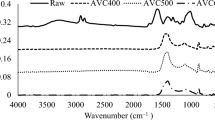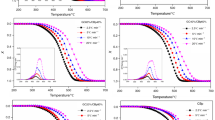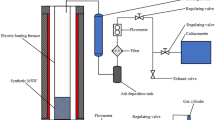Abstract
The disposal of finished leather waste (FLW) is difficult, and randomly discarding it may cause pollution to the environment. Because of its high calorific value (~ 16 MJ/kg), FLW could be a potential candidate material for bioenergy production. In this research, the combustion characteristics of FLW were studied using thermogravimetric analysis (TG), and the Flynn–Wall–Ozawa (FWO) and Coats–Redfern (C–R) methods were used to analyze the combustion kinetics. The TG results showed that the main weight loss stage occurred at 230–400 ℃, and the combustion efficiency increased with increasing heating rates. The average activation energies of the uncoated finished leather (UCFL) waste and coated finished leather (CFL) waste in the combustion stage obtained using the FWO method were 261.98 and 218.83 kJ/mol, respectively, which means that the CFL material is easier to burn due to its strong catalytic effect. The C–R analysis results showed that the thermal decomposition stage of FLW can be represented by the assumed random nucleation and its subsequent growth, the rapid combustion stage of collagen fibers by a power law model, and the combustion stage of polymer film-forming substances by a chemical reaction model. Finally, the incineration experiment showed that the removal of organic matter from FLW can be achieved at 800 ℃. However, the incineration ash needs to be disposed of safely because of the Cr(VI) content exceeding the emission limit of 0.25 mg/g (GB15618-2018). These results will help to integrate FLW into municipal incineration systems and provide theoretical guidance for appropriate measures to address the pollution generated in the future.












Similar content being viewed by others
Data availability
The authors declare that all data included in this study are available upon request by contact with the corresponding author
References
Şaşmaz S, Karaağaç B, Uyanık N (2019) Utilization of chrome-tanned leather wastes in natural rubber and styrene-butadiene rubber blends. J Mater Cycles Waste Manag 21:166–175
J., Kanagaraj, K., C., Velappan, N., K., Chandra, Babu, S. (2006) Solid wastes generation in the leather industry and its utilization for cleaner environment. ChemInform 37:no-no
Kolomaznik K, Adamek M, Andel I, Uhlirova M (2008) Leather waste—potential threat to human health, and a new technology of its treatment. J Hazard Mater 160:514–520
Costa M (1991) DNA-protein complexes induced by chromate and other carcinogens. Environ Health Perspect 92:45–52
Pellerin C, Booker SM (2000) Reflections on hexavalent chromium: health hazards of an industrial heavyweight. Environ Health Perspect 108:A402–A407
Wise JP, Young JL, Cai J, Cai L (2022) Current understanding of hexavalent chromium [Cr(VI)] neurotoxicity and new perspectives. Environ Int 158:106877
Technique C, C Chaussure (2000) Fourteenth Session of the WASTES GENERATED Prepared by
Wang L, Li J, Jin Y, Chen M, Luo J, Zhu X, Zhang Y (2019) Study on the removal of chromium(III) from leather waste by a two-step method. J Ind Eng Chem 79:172–180
Senthil R, Hemalatha T, Kumar BS, Uma TS, Das BN, Sastry TP (2015) Recycling of finished leather wastes: a novel approach. Clean Technol Environ Policy 17:187–197
Teklay A, Gebeyehu G, Getachew T, Yaynshet T, Sastry TP (2017) Preparation of value added composite boards using finished leather waste and plant fibers—a waste utilization effort in Ethiopia. Clean Technol Environ Policy 19:1285–1296
Rethinam, Senthil, Sundaramurthy, Inbasekaran, Nallathambi, Gobi, Bhabendra, Nath, Das, Thotapalli (2015) Utilisation of finished leather wastes for the production of blended fabrics. Clean Technol Environ Policy
Chronska K, Przepiorkowska A (2008) Buffing dust as a filler of carboxylated butadiene-acrylonitrile rubber and butadiene-acrylonitrile rubber. J Hazard Mater 151:348–355
Liu C, Huang Y, Dong L, Duan L, Xu L, Wang Y (2020) Combustion characteristics and pollutants in the flue gas during shoe manufacturing waste combustion in a 2.5 MWth pilot-scale circulating fluidized bed. Waste and Biomass Valorization 11:1603–1614
Bahillo A, Armesto L, Cabanillas A, Otero J (2004) Thermal valorization of footwear leather wastes in bubbling fluidized bed combustion. Waste Manag 24:935–944
Fang C, Jiang X, Lv G, Yan J, Deng X (2018) Nitrogen-containing gaseous products of chrome-tanned leather shavings during pyrolysis and combustion. Waste Manag 78:553–558
Kluska J, Turzyński T, Kardaś D (2018) Experimental tests of co-combustion of pelletized leather tannery wastes and hardwood pellets. Waste Manag 79:22–29
Swarnalatha S, Kumar AG, Tandaiah S, Sekaran G (2009) Efficient and safe disposal of chrome shavings discharged from leather industry using thermal combustion. J Chem Technol Biotechnol 84:751–760
Yang Y, Zhu C, Wang H, Hao Y, Yan L, Zhang Z, Yan H, Chen X, Ma H (2022) Synergistic immobilization of Cr from real tannery sludge by formation of spinel phases with TiO2 and ZnO. J Environ Chem Eng 10:108679
Gao B, Jiang H, Chen H, Peng M, Zhang W, Hu L, Mao L (2023) The introduction of sulfates to suppress Cr (III) oxidation during incineration of tannery sludge and reduce leachability toxicity of incineration residue. J Clean Prod 382:135272
Zhang HL, Liang ST, Luo MT, Ma MG, Fan PP, Xu HB, Li P, Zhang Y (2014) Preparation and color performance control of Cr2O3 green pigment through thermal decomposition of chromium hydroxide precursor. Mater Lett 117:244–247
Dettmer A, Nunes KGP, Gutterres M, Marcílio NR (2010) Obtaining sodium chromate from ash produced by thermal treatment of leather wastes. Chem Eng J 160:8–12
Alves CR, de Buzin PJWK, Heck NC, Schneider IAH (2012) Utilization of ashes obtained from leather shaving incineration as a source of chromium for the production of HC-FeCr alloy. Miner Eng 29:124–126
Basegio T, Haas C, Pokorny A, Bernardes AM, Bergmann CP (2006) Production of materials with alumina and ashes from incineration of chromium tanned leather shavings: Environmental and technical aspects. J Hazard Mater 137:1156–1164
Guan Y, Liu C, Peng Q, Zaman F, Zhang H, Jin Z, Wang A, Wang W, Huang Y (2019) Pyrolysis kinetics behavior of solid leather wastes. Waste Manag 100:122–127
Zhang J, Kang G, Yang H, Liu Z, Yu J, Gao S (2021) Co-pyrolysis kinetics and pyrolysis product distribution of various tannery wastes. J Fuel Chem Technol 49(1638):1647
Si L, Fan Y, Wang Y, Sun L, Li B, Xue C, Hou H (2018) Thermal degradation behavior of collagen from sea cucumber (Stichopus japonicus) using TG-FTIR analysis. Thermochim Acta 659:166–171
Xu W, Li J, Liu F, Jiang Y, Li Z, Li L (2017) Study on the thermal decomposition kinetics and flammability performance of a flame-retardant leather. J Therm Anal Calorim 128:1107–1116
Li Q, Zhao C, Chen X, Wu W, Li Y (2009) Comparison of pulverized coal combustion in air and in O2/CO2 mixtures by thermo-gravimetric analysis. J Anal Appl Pyrolysis 85:521–528
Zhou Z, Hu X, You Z, Wang Z, Zhou J, Cen K (2013) Oxy-fuel combustion characteristics and kinetic parameters of lignite coal from thermo-gravimetric data. Thermochim Acta 553:54–59
Guo L, Zhai M, Wang Z, Zhang Y, Dong P (2019) Comparison of bituminous coal and lignite during combustion: Combustion performance, coking and slagging characteristics. J Energy Inst 92:802–812
Moon C, Sung Y, Ahn S, Kim T, Choi G, Kim D (2013) Effect of blending ratio on combustion performance in blends of biomass and coals of different ranks. Exp Therm Fluid Sci 47:232–240
Jiang L, Zhang D, Li M, He J-J, Gao Z-H, Zhou Y, Sun J-H (2018) Pyrolytic behavior of waste extruded polystyrene and rigid polyurethane by multi kinetics methods and Py-GC/MS. Fuel 222:11–20
Chen R, Li Q, Xu X, Zhang D, Hao R (2020) Combustion characteristics, kinetics and thermodynamics of Pinus Sylvestris pine needle via non-isothermal thermogravimetry coupled with model-free and model-fitting methods. Case Stud Therm Eng 22:100756
Amer M, Brachi P, Ruoppolo G, El-Sharkawy I, Ahmed M, Ookawara S, Elwardany A (2021) Pyrolysis and combustion kinetics of thermally treated globe artichoke leaves. Energy Convers Manag 246:114656
Tong W, Cai Z, Liu Q, Ren S, Kong M (2020) Effect of pyrolysis temperature on bamboo char combustion: reactivity, kinetics and thermodynamics. Energy 211:118736
Doyle CD (1962) Estimating isothermal life from thermogravimetric data. J Appl Polym Sci 6:639–642
Wang J, Wang S (2019) Preparation, modification and environmental application of biochar: a review. J Clean Prod 227:1002–1022
Velusamy M, Chakali B, Ganesan S, Tinwala F, Venkatachalam SS (2020) Investigation on pyrolysis and incineration of chrome-tanned solid waste from tanneries for effective treatment and disposal: an experimental study. Environ Sci Pollut Res 27:29778–29790
Cucos A, Budrugeac P (2014) Simultaneous TG/DTG–DSC–FTIR characterization of collagen in inert and oxidative atmospheres. J Therm Anal Calorim 115:2079–2087
Xu M, Cao C, Hu H, Ren Y, Guo G, Gong L, Zhang J, Zhang T, Yao H (2022) Perspective on the disposal of PVC artificial leather via pyrolysis: thermodynamics, kinetics, synergistic effects and reaction mechanism. Fuel 327:125082
Chen R, Lu S, Zhang Y, Lo S (2017) Pyrolysis study of waste cable hose with thermogravimetry/Fourier transform infrared/mass spectrometry analysis. Energy Convers Manag 153:83–92
Ren Y, Cao C, Hu H, Lei S, Yuan X, Li X, Yao H (2022) Transformation behavior and fate of chlorine in polychloroprene (PCP) during its pyrolysis. Fuel 317:123573
Liang W, Jiang C, Wang G, Ning X, Zhang J, Guo X, Xu R, Wang P, Ye L, Li J, Wang C (2022) Research on the co-combustion characteristics and kinetics of agricultural waste hydrochar and anthracite. Renew Energy 194:1119–1130
Lopez G, Alvarez J, Amutio M, Hooshdaran B, Cortazar M, Haghshenasfard M, Hosseini SH, Olazar M (2019) Kinetic modeling and experimental validation of biomass fast pyrolysis in a conical spouted bed reactor. Chem Eng J 373:677–686
Lyu B, Luo K, Gao D, Wang Y, Ma J (2021) Modified layered double hydroxide/zanthoxylum bungeanum seed oil composites to improve the flame retardant of leather. Polym Degrad Stab 183:109430
An W, Ma J, Xu Q (2021) Bio-template synthesis of MgAl layered double hydroxide with enhanced flame retardant property for leather finishes. Appl Surf Sci 551:149409
Cao CY, Zhang D, Liu CC, Lu S, Zhang HP (2019) Experimental investigation on combustion behaviors and reaction mechanisms for 5-aminotetrazole solid propellant with nanosized metal oxide additives under elevated pressure conditions. Appl Therm Eng 162:114207
Khawam A, Flanagan DR (2010) Solid-state kinetic models: basics and mathematical fundamentals. J Phys Chem B 110:17315–17328
Islam MA, Kabir G, Asif M, Hameed BH (2015) Combustion kinetics of hydrochar produced from hydrothermal carbonisation of Karanj (Pongamia pinnata) fruit hulls via thermogravimetric analysis. Bioresour Technol 194:14–20
Berry FJ, Costantini N, Smart LE (2002) Synthesis of chromium-containing pigments from chromium recovered from leather waste. Waste Manag 22:761–772
Yang T, Zhi C, Hao Z, Ming Z, Wang T (2016) Multifunctional Cr2O3 quantum nanodots to improve the lithium-ion storage performance of free-standing carbon nanofiber networks. Electrochim Acta 217:55–61
Dhal B, Thatoi HN, Das NN, Pandey BD (2013) Chemical and microbial remediation of hexavalent chromium from contaminated soil and mining/metallurgical solid waste: a review. J Hazard Mater 250–251:272–291
Apte AD, Verma S, Tare V, Bose P (2005) Oxidation of Cr(III) in tannery sludge to Cr(VI): field observations and theoretical assessment. J Hazard Mater 121:215–222
Apte AD, Tare V, Bose P (2006) Extent of oxidation of Cr(III) to Cr(VI) under various conditions pertaining to natural environment. J Hazard Mater 128:164–174
Author information
Authors and Affiliations
Contributions
Mengru Li, methodology, experimentation, data collation and analysis, writing-original draft; Yanchun Li, methodology, supervision, writing-review and editing, language refinement; Jie Liu, supervision, editing, proof reading, language refinement; Shan Cao, proof reading, language refinement.
Corresponding author
Ethics declarations
Ethics approval and consent to participate
This work does not contain any potential conflicts of interest and any studies with human participants or animals. All authors provided informed consent to participate in this study.
Competing interest
The authors declare no competing interests.
Additional information
Publisher's note
Springer Nature remains neutral with regard to jurisdictional claims in published maps and institutional affiliations.
Rights and permissions
Springer Nature or its licensor (e.g. a society or other partner) holds exclusive rights to this article under a publishing agreement with the author(s) or other rightsholder(s); author self-archiving of the accepted manuscript version of this article is solely governed by the terms of such publishing agreement and applicable law.
About this article
Cite this article
Li, M., Li, Y., Liu, J. et al. Combustion characteristics and kinetic analysis of finished leather waste using TG-DSC and transformation behavior of Cr during its combustion. Biomass Conv. Bioref. (2023). https://doi.org/10.1007/s13399-023-03974-8
Received:
Revised:
Accepted:
Published:
DOI: https://doi.org/10.1007/s13399-023-03974-8




